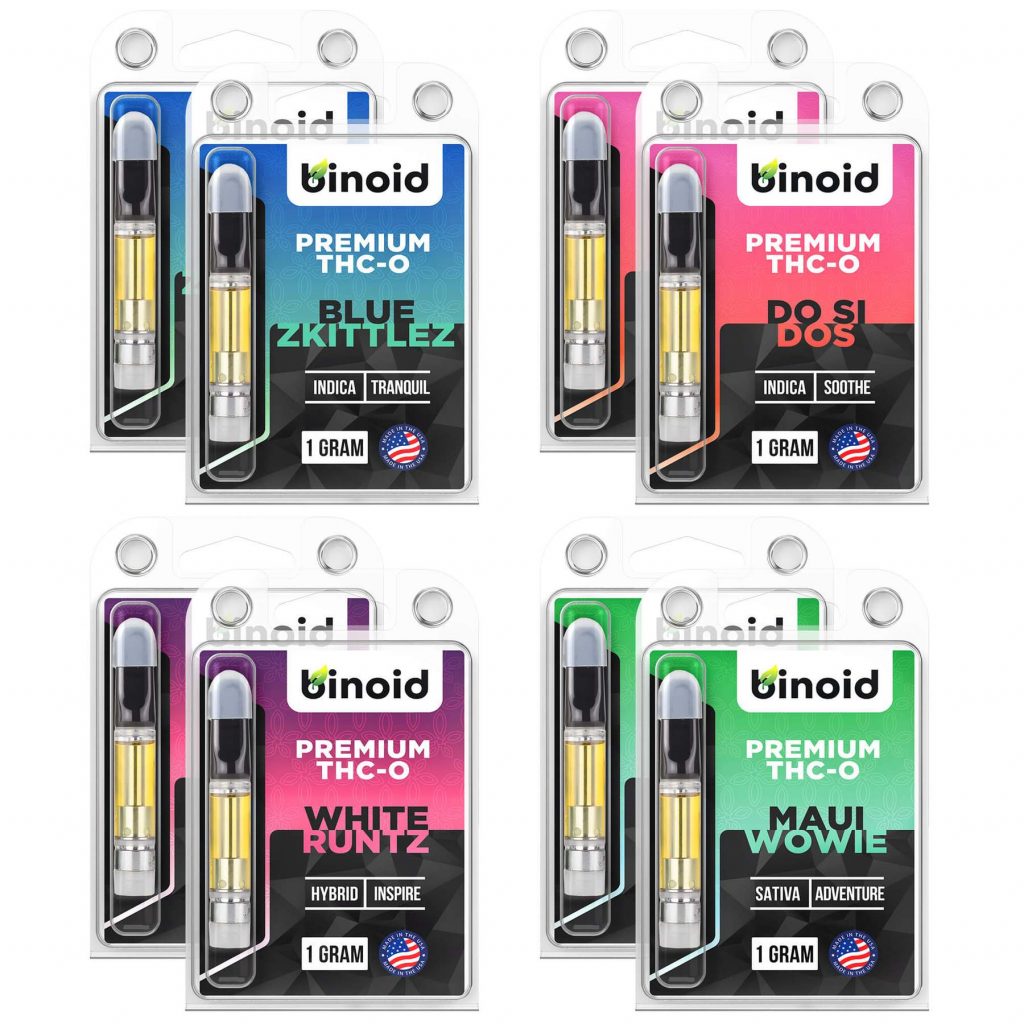Pretty much every other day, we’re finding about some new part, or some new invention, of the cannabis plant. One of the more interesting ones to make news recently? THC-O-Acetate. Here, we’ll go into what this psychedelic compound is, how THC-O-Acetate was discovered, and the military abuses that went along with it.
The psychedelic THC-O-Acetate sure sounds interesting, and goes to show just how many different products can be made from cannabis. Compounds like that one, THCV, Delta-8 THC and Delta 10 are the newer face of the cannabis industry. We support the expansion of cannabis use, and have some really great deals for delta-8 THC and many other compounds. Take a look at our selection, and join the cutting edge of marijuana use.
What is THC-O-Acetate?
THC-O-Acetate is what’s called an acetate ester of delta-9 THC. Let’s break that down. So, we’ve got our standard delta-9 THC to begin with. This is the main psychoactive part of the cannabis plant, which is produced naturally through the decarboxylation of its parent compound THCA. We also already know of slightly different versions of this compound. We know that if you move the double bond in delta-9, that it creates a stereoisomer like delta-8, or delta-10, or delta-7 THC. We know that if you eat it, it gets metabolized into something slightly different – 11-hydroxy-THC. We even know that CBD is a direct isomer of delta-9 sharing the exact same chemical formula, but with a different configuration of atoms.
So, what does it mean to have an acetate ester? Well, this is where it gets to slightly higher-level chemistry, which might be hard to understand, but which should be gone over briefly. Interested parties can investigate further for a better understanding. Basically, an acetate ester is a product of a form of decarboxylation called LTA decarboxylation. We know decarboxylation means losing a carboxyl group, but there are different ways for this to happen.
The one we are most familiar with when dealing with cannabis, is heat/time induced decarboxylation, but there are other processes by which decarboxylation happens using chemicals instead. One is LTA decarboxylation, which uses lead tetraacetate (very toxic), a compound that promotes oxidation, to create oxidative decarboxylation. One of the byproducts of this, is acetate ester. This acetate ester does not occur naturally in nature, and must be synthesized from the chemical processing of delta-9, or THCA. THC-O-Acetate is a synthetic analogue of delta-9.

It is said that this compound is 2-3X the potency of standard delta-9, and that unlike other known cannabinoids, there is a psychedelic effect produced by THC-O-Acetate. Also, unlike standard delta-9, THC-O-Acetate’s effect can take about 30 minutes to kick in. So where did this compound come from, and why do we know about it anyway? Well, that sure is one messed up story!
Best THC-O Carts: Top THC-O Vape Cartridges of 2021
Edgewood Arsenal human experiments & the US Military
Much like many other compounds we’re only widely hearing about now, like delta-8 and delta-10, THC-O-Acetate was discovered several decades back, sometime between 1949-1974. In 1974, the above referenced instructions for synthesis were put out by Dr. Gold, in which he dubbed the compound with the name THC-O-Acetate. If it seems like 1949-1974 is quite a big window, and not terribly specific, there is a reason why.
As stated, this is not a naturally occurring compound, and non-naturally occurring compounds have to be discovered. It’s hard to pin down a direct date, which is probably because the compound was used between the years of 1949-1975 by the US military, in what was called the Edgewood Arsenal Experiments. As the US military generally performs its human-rights abuses under the cover of night, its not shocking that when exactly it was made, is hard to say.
What were these awesome, and secretive-enough-that-barely-anyone-knows-about-them-even-today studies? The Edgewood Arsenal Human Experiments were conducted between 1948-1975 in the Edgewood Arsenal facility in Maryland. Testing was run by the US Army Chemical Corps, with the stated reason being to assess how chemical warfare agents in low doses, can affect military personnel, as well as testing protective clothing, vaccines, and other pharmaceuticals.
Part of these studies had to do with psychochemical warfare, studied under the ‘Medical Research Volunteer Program’ which existed from 1956-1975. The psychedelic THC-O-Acetate was looked at as a possible non-lethal method of incapacitation, and was compared alongside drugs like LSD and benzodiazepines. All told, the Edgewood experiments subjected around 8,000 people (military and not) to three decades of experimentation, with no follow-up ever planned to assess damage to participants, even as test subjects experienced symptoms of exposure to agents.
If it all sounds horribly shady and terrible, it was. Enough that in 1975 the experiments were abruptly cut off, and all test subjects removed from the facility. The doctor who founded and directed the program, Dr. Van Murray Sim was called before congress and yelled at by law-makers, particularly for not providing any follow-up care to participants. The army investigated it and didn’t find any injury, but considering the army ran the experiments, expecting the same entity which performed the human rights abuses, to fairly investigate into them, is about as useful as having a pharmaceutical company put out its own test results, as fact.
The reality, which has trickled out over time, is that soldiers weren’t exactly given the choice about being in these experiments, but were forced through threats of jail or Vietnam. And the idea that no one was hurt is ludicrous considering what was being tested, like tear gas, sarin gas, and the deadly BZ. Soldier stories do not in any way match the army line of ‘no one was hurt.’ This whole study represents the awfulness and gravity of US military abuses, and the complicity of the US government.
What does this mean about the psychedelic THC-O-Acetate?
The weirdest part about THC-O-Acetate, and its initial creation, is that there doesn’t seem to be any information released on it. Not on how it was found, the reasons it was being synthesized, or what it even does. Whatever the military learned about it, was never shared with the rest of us. While we spend a lot of time being unsure of this compound, and what exactly it does, the military already knows, and simply never released the information.
An interesting note about THC-O-Acetate… It was actually being used recreationally for quite some time, and is one of the only analogues of THC that has been used recreationally in smokable form. My guess? It was likely released by the army at the time of testing, to either sell to the public, or to see what would happen to the public. In fact, it seems like the army might well have conducted two experiments with this particular compound, one in-house, and one on the street. This, of course, is just my supposition.
As more time goes on, and other entities besides the army study this compound, more can be said about it. As of right now, the lack of information available to the public is paltry at best, with the best evidence of some sort of safety being that it has been used for years as a recreational drug, without any awful stories attached. Although its also quite possible that if there was a big negative story, that it would have been suppressed by the military.
Is this psychedelic THC-O-Acetate compound legal?
No, and hardly up for debate, though I obviously can’t make that statement outright, and realistically, it could probably be argued in court to some degree. However, the basics are that its not legal, and the reason is pretty straightforward, and not without reason. THC-O-Acetate is a synthetic analogue of delta-9 THC. All analogues of illegal substances, are automatically illegal under the Federal Analogue Act. Plus, it’s a synthetic, which means it doesn’t matter where it’s sourced from, its illegal.
Now, like I said, it doesn’t mean someone can’t take it to court, but unlike delta-8 THC, where there’s a grain of reasonability, there unfortunately is not with THC-O-Acetate. Does this mean there won’t be a THC-O-Acetate industry? Not at all, and it seems that not only has one been around for awhile, but it’s only growing bigger with more public knowledge of its existence. In fact, much like delta-8 THC, THC-O-Acetate looks like it will continue to bolster the cannabis black market.

Why did I say the illegality is not without reason? It’s very easy to think that whatever comes out of a plant like cannabis has to be okay, but synthetics don’t come directly out of the plant, and don’t exist by themselves in nature, and we don’t know why. It could be that compounds like delta-10 and THC-O-Acetate simply happened to not be compounds produced by the plant in those configurations, but for no particular reason. But it also could be that when we don’t see something show up in nature, that there is a reason.
Maybe some particular formulations could actually be poisonous, or cause nerve damage, instigate heart attacks, or lead to sudden death. Maybe they don’t exist in nature, because nature doesn’t support their existence. And without testing, we don’t know. While it’s a safer bet to trust a synthetic of a compound that does exist, it is very questionable to assume that anything made as a synthetic from the plant, will have the same level of safety. For this reason, interested buyers should do what they can to ensure their own safety by knowing the processing details, chemicals used, and the site/store they are buying from.
Conclusion
There’s actually not much to say about THC-O-Acetate in the end, because almost nothing is known about it. I mean, sure, the army knows a lot by now, but that doesn’t help the rest of us. In a way, it’s very cool that psychedelic effects can be obtained from a delta-9 analogue like THC-O-Acetate, but THC-O-Acetate also represents the awfulness of the government and the military, how far those entities will go for their own purposes – regardless of the threat to the public, and the overall secretiveness employed even about general research topics.
This could be a promising synthetic, but like all synthetics, it’s not about to be legalized. If THC-O-Acetate has a real future, it’ll most likely be as a pharmaceutical product.
Hello! Welcome to CBDtesters.co, your best online spot for the most relevant and interesting cannabis-related news globally. Check the site out frequently to stay current on the quickly changing world of legal cannabis, and sign up to receive our newsletter, so you never miss a thing.
Disclaimer: Hi, I’m a researcher and writer. I’m not a doctor, lawyer, or businessperson. All information in my articles is sourced and referenced, and all opinions stated are mine. I am not giving anyone advise, and though I am more than happy to discuss topics, should someone have a further question or concern, they should seek guidance from a relevant professional.









